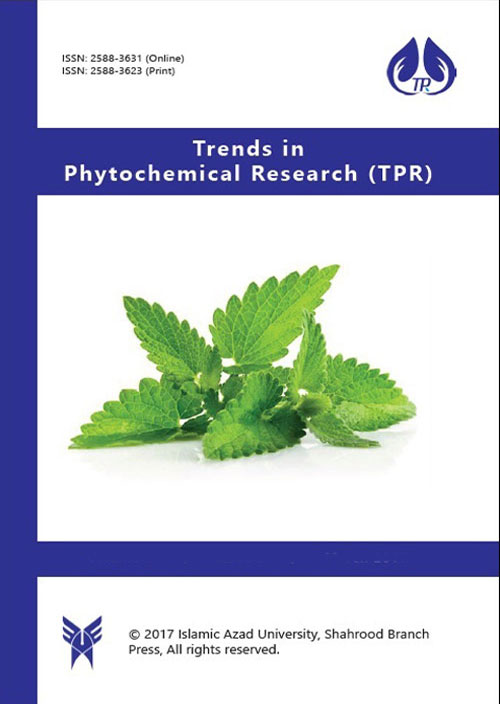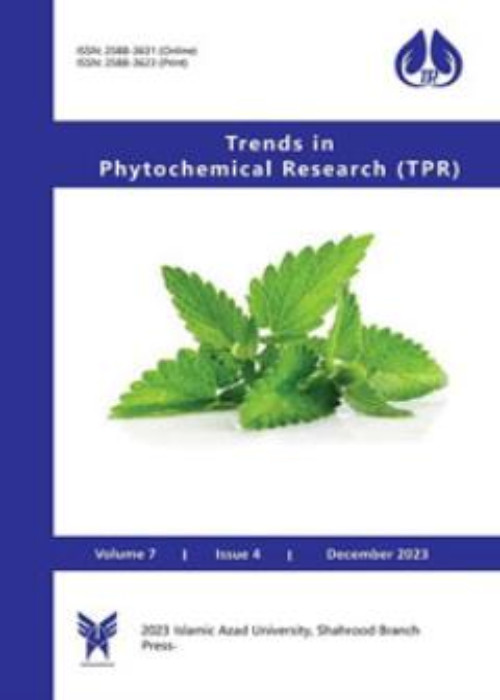فهرست مطالب

Trends in Phytochemical Research
Volume:5 Issue: 2, Spring 2021
- تاریخ انتشار: 1400/03/25
- تعداد عناوین: 6
-
-
Pages 45-46
Arbutus pavarii Pamp. (fam. Ericaceae), commonly known as “Shmeri” or “Libyan Strawberry”, is an endemic Libyan medicinal plant, currently considered as an endangered species of shrub or tree (Kabiel et al., 2016), and has attracted public attention in relation to its conservation. The distribution of this important forage species of plant for honeybees to produce specific honey type is considerably confined to the Al-Akhdar mountainous region in Libya.
Keywords: Arbutin, Arbutus pavarii Pamp, Chemotaxonomic marker, Ericaceae, Forage -
Pages 47-61This study was designed to evaluate and compare the phytochemical constituents along with the bioactivities of Solanum khasianum C.B. Clarke. leaves (SKLME) and berries (SKBME) methanolic extracts. Alkaloids, flavonoids, saponins, steroids, terpenoids, phenols, oxalates and cardiac glycosides were present in SKLME and SKBME. Considerable amounts of phenolic and flavonoids were found in SKLME and SKBME. SKBME showed better antioxidant activity with an IC50 value of 20.68 μg/mL vs SKLME (38.30 μg/mL). SKBME and SKLME respectively showed anti-inflammatory activity with IC50 of 20.96 and 23.37 μg/mL. Apart from this, the present investigation also reports SKBME skin whitening ability, anti-diabetic potential and anti-cholinesterase activity with IC50 values of 33.97, 28.24, and 32.42 μg/mL, respectively. Furthermore, SKLME showed herbicidal property with a total germination rate of 9.06% at a concentration of 80 μg/mL. Bioactivity analysis revealed higher pharmacological importance of the SKBME than SKLME, as well.Keywords: Acetylcholinesterase, Amylase, Anti-inflammatory, Solanaceae, Solanum khasianum C.B. Clarke, Tyrosinase
-
Pages 62-70
Plant pathogens lead to severe damage of the agricultural crops, worldwide. The disease management is currently being done by the synthetic chemicals. In the present report, Cinnamomum tamala (Buch.-Ham.) T. Nees & Eberm. oil was analyzed by gas chromatography-FID and GC/MS, which revealed (E)-cinnamaldehyde (40.6%), (E)-cinnamyl acetate (19.6%), linalool (10.2%) and benzaldehyde (3.6%) as marker constituents. Contact, volatile and spore germination inhibition assays were performed to determine the antifungal activities of Cinnamomum tamala (Buch.-Ham.) T.Nees & Eberm. against Rhizoctonia solani AG 4, Choanephora cucurbitarum and Bipolaris australiensis. C. tamala oil 500-560 ppm showed complete fungal growth inhibition in poison food technique over concentration range of. Solid-phase microextraction analysis of drop diffusion assay revealed the presence of benzaldehyde in headspace of Petri-plate, and found to be one of the strongest antifungal compounds against tested phytopathogens. Similarly, an oil concentration of 500 ppm inhibits spore germination. Therefore, products containing such compositions can be used for the plant diseases management.
Keywords: Antifungal activity, (E)-Cinnamaldehyde, Cinnamomum tamala (Buch.-Ham.) T.Nees & Eberm, Rhizoctonia solani AG 4, Solid phase microextraction(SPME) fiber, Spore germination inhibition -
Pages 71-92< p>This study divulges a comparative analysis of Berberis tinctoria Lesch. leaf, stem, and fruit towards proximate contents assessment, e.g., moisture, crude-ash, crude-fibre, crude-lipid, crude-protein, nitrogen-free extract, energy followed by ICP-MS analysis which revealed that fruits have a higher amount of essential minerals. The primary metabolites were higher in the fruit extract, whereas more secondary metabolites were observed in the methanolic extracts in the hierarchy of leaf and fruit then stem, respectively. Likewise, a higher amount of antioxidant activities were observed in ethyl acetate and methanolic extracts. The fruit ethyl acetate extract showed a maximum of 95.27% anti-inflammatory activity. The fruit methanolic extract exhibited an antidiabetic activity with IC50 values of 75.5 ± 6.8 μg/mL and 45.4 ± 11.1 μg/mL for α-amylase and α-glucosidase, respectively. A significantly positive correlation was identified between the secondary metabolites and antioxidant activities. The principal component analysis implies ethyl acetate and methanolic extracts as pivotal extracts of B. tinctoria.Keywords: Antidiabetic, Anti-inflammatory, Antioxidant, Berberis tinctoria Lesch, micronutrients, Proximate analysis
-
Pages 93-104The phytochemical screening, total phenolics and flavonoids content and antioxidant activity of plants native to western Ecuador were investigated to provide the basic information for further studies towards the discovery of new compounds. The species studied were Adenostemma platyphyllum Cass, Castilla elastica subsp . gummifera (Miq.) C.C. Berg., Cochlospermum vitifolium (Willd.) Spreng., Ectozoma pavonii Miers, Erythrochiton giganteus Kaastra & A.H. Gentry, Erythroxylum patens Ruiz ex O.E.Schulz, Ficus brevibracteata W.C. Burger, Ficus tonduzii Standl., Grias ecuadorica Cornejo & S.A. Mori, Handroanthus billbergii subsp . ampla (Bureau K. Schum.) S.O. Grose, Morisonia americana L., Operculina codonantha (Benth.) Hallier f., Passiflora macrophylla Spruce ex Mast., Podandrogyne jamesonii (Briq.) Cochrane, Pradosia montana T.D. Penn., Tecoma castaneifolia (D.Don) Melch, Urera baccifera (L.) Gaudich. ex Wedd., and Xanthosoma sagittifolium (L.) Schott.The highest percentage of inhibition of DPPH• was found in E. patens (92.41%). Most of the extracts evaluated exhibited antioxidant activity.Keywords: DPPH•, Ecuadorian plants, Flavonoids, phenols
-
Pages 105-109One new coumarinolignan, cleomiscosin F (1) along with ten known compounds namely 3,4-secotirucalla-4(28),7,24-trien-21-hydroxy-21,23-epoxy-3-oic acid (2), 3,4-secotirucalla-4(28),7,24-trien-3,21-dioic acid (3),ceramid A (4),ceramid B (5), mayombensin (6),aridanin (7), stigmasterol and β-sitosterol and their glucosides were isolated from the seeds and roots of Leplaea mayombensis (Meliaceae).Thestructures of the compounds were elucidated based on the interpretation of their spectroscopic data. Some of the isolated compounds (3, 4 and 5) were tested in vitro against bacteria strains Escherichia coli, Bacillus subtilis, Pseudomonas agarici, and Micrococcus luteus. Compound 3 displayed good activity against Bacillus subtilis, Micrococcus luteus, and Pseudomonas agarici with MIC values of 1.7, 2.3 and 9.8µM, respectively; while compound 4 showed significant activity against Micrococcus luteus with MIC value of 11.9µM.Keywords: Antibacterial activity, coumarinolignan, Leplaea mayombensis, Minimum inhibitory concentration


